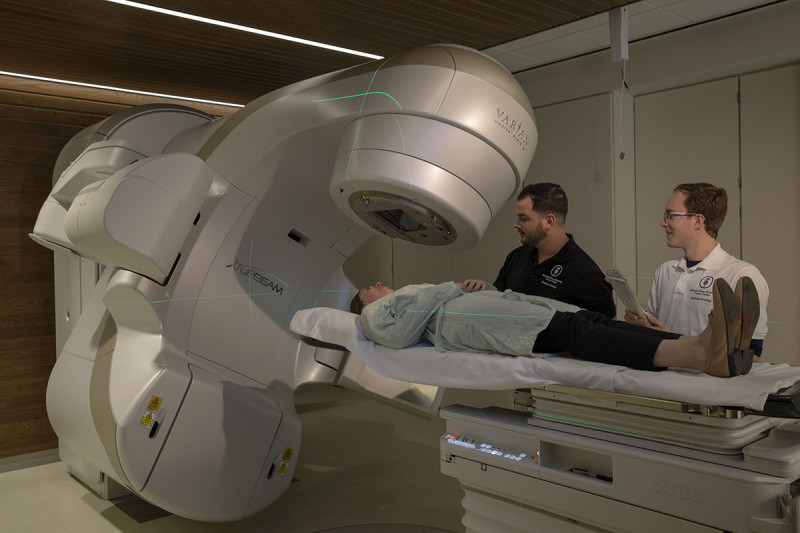
Radiation is a feasible option for patients with squamous cell carcinoma of the anterior nasal cavity mucosa who refuse rhinectomy, according to our research, which was published recently in the journal Head & Neck.
Our findings demonstrate that a non-operative approach with high-dose radiotherapy and concurrent chemoradiotherapy can result in favorable outcomes.
Together with our colleagues, we analyzed the results for 11 patients who refused surgery and were treated with radiation, with or without chemotherapy, at Memorial Sloan Kettering Cancer Center between January 2000 and July 2018. Three patients refused a partial resection or near-total resection, and eight refused a total rhinectomy. Eight of the 11 patients had stage III or IV cancer. All of the patients were treated with a selection of induction chemotherapy, radiotherapy (either intensity-modulated radiotherapy [IMRT] or intensity-modulated proton radiotherapy [IMPT]), and all but one patient received concurrent chemoradiotherapy. (1)
After a median follow-up period of 15 months (range three to 124 months), the two-year rhinectomy-free survival rate was 88 percent, and the two-year overall survival and recurrence-free survival rates were 100 percent and 75 percent, respectively. (1)
Advances in radiotherapy techniques, such as IMPT, have significantly reduced severe toxicities while allowing for higher doses to be delivered to target volumes, improving locoregional control. However, a chemoradiation approach is not free from side effects. At MSK, multidisciplinary experts collaborate to develop optimized treatment plans for each patient. When a patient refuses surgery, we offer a tailored, nonsurgical approach with careful consideration of the target volume and selection of concurrent chemotherapy.
Nasal Cancer
Nasal and paranasal cancers are uncommon. About 2,000 new cases are diagnosed annually in the United States, representing about 3 percent of all head and neck cancers. (2) Squamous cell carcinoma is the most common subtype, found in 50 to 75 percent of cases. The rest include adenocarcinoma and other rare histologies, such as adenoid cystic carcinoma, melanoma, and lymphoma. (6), (7)
Standard treatment for squamous cell carcinoma of the nasal cavity includes total surgical resection and postoperative radiotherapy, which achieves locoregional control in 80 to 85 percent of cases. (5) In contrast to early-stage cancers of the ethmoid or maxillary sinuses, resection of early-stage anterior nasal cavity cancers with partial or total rhinectomy can be disfiguring. Modern prostheses and reconstruction methods have come a long way to improve cosmetic outcomes, but disfigurement is still a significant source of distress for many patients. (3), (4)
Treatment Details
Given the lack of published evidence on outcomes among patients with initially resectable tumors who declined partial or total rhinectomy and received definitive radiotherapy, with or without chemotherapy, we reviewed the health records of all patients treated with this nonsurgical approach at MSK between January 2000 and July 2018. (1)
Among 11 patients identified, the median age at diagnosis was 66 years (range 38 to 86 years), and 64 percent were men. Nine patients (82 percent) had a history of tobacco consumption. Clinical T classification was as follows: one T1, two T2, four T3, and four T4. Eight patients had moderately differentiated squamous cell carcinoma. Interestingly, four tumors tested positive for p16 status via immunohistochemistry. (1) The sensitively of p16-positive oropharyngeal cancer to chemoradiotherapy is well documented. (8)
Three patients received induction chemotherapy: One received cisplatin, docetaxel, and everolimus, and two received carboplatin and paclitaxel. All of the patients were treated with definitive radiation therapy: Four received IMRT, and seven received IMPT. Seven patients received concurrent chemoradiotherapy in the form of cisplatin, and three received carboplatin and paclitaxel. One patient had no concurrent chemotherapy. (1)
Four patients received IMRT, and seven received IMPT. The median radiation dose was 70 gray (Gy) for photon-based cases and 70 cobalt Gy equivalent for proton cases using a generic, relative biological effectiveness of 1.1. Patients were treated in 1.8 to 2 Gy/CGE fractions. (1) During the study period, the radiotherapy field design and technical details were fairly consistent. Endoscopic assessments took place at least every three months for the first year and every six months after the first year up to the fifth year post-treatment. (1)
Study Results
After the median follow-up of 15 months (range three to 124 months), two patients experienced recurrence, and one developed distant metastases in the neck and lung and ultimately died from the disease. (1)
The rhinectomy-free, overall, and recurrence-free survival rates at two years were 88, 100, and 75 percent, respectively. At last follow-up, locoregional control was achieved in eight of 11 patients. One patient who received IMPT without concurrent chemotherapy developed locally recurrent disease after ten months and required a salvage total rhinectomy and neck dissection. The recurrence was identified as T1 N0 disease, and the patient was cancer free at last follow-up. (1)
The most common treatment-related side effects were mucositis, dermatitis, dry mouth, and dysphagia, and 72 percent were grade 1 or 2 according to the Radiation Therapy Oncology Group criteria. Two patients experienced a grade 4 toxicity and required hospitalization: One had dermatitis complicated with cellulitis, and the other had mucositis, dermatitis, and dehydration and did not complete treatment. Four patients developed xerostomia during follow-up, two developed septal perforation without functional impact, and four experienced post-treatment synechiae and partial stenosis. One patient required endoscopic sinus surgery to divide the synechiae, and one had a saddle nose deformity and received cosmetic surgery for aesthetic purposes. (1)
Advancing Treatment Options for Nasal Cancer
Overall, our study demonstrates that nonoperative management of anterior nasal cavity squamous cell carcinoma is feasible and can result in favorable outcomes when patients are treated with high-dose radiotherapy and concurrent chemotherapy. Limitations of the study include the small number of cases, short follow-up periods, and the retrospective nature of the analysis.
Our study is one of few that have evaluated the feasibility of nonsurgical treatment approaches for patients with initially operable cancers of the anterior nasal cavity. (2), (9) Compared to prior studies of definitive radiotherapy and chemoradiotherapy for nasal cancers, our analysis differed in four ways: All patients were treatment naive and had resectable squamous cell carcinoma; patients uniformly received high doses of radiotherapy; almost 90 percent of patients received platinum-based chemotherapy; and 56 percent of patients received IMPT. (1) Survival rates were significantly higher compared to a historical cohort published in 2007 that included 85 patients with nasal and paranasal cancers who were treated with surgery and postoperative radiotherapy. In that cohort, the most common histology was squamous cell carcinoma in 24 patients. The reported five-year overall survival and recurrence-free survival rates were 67 and 55 percent, respectively. (10)
At MSK, we are dedicated to finding new ways to help patients achieve the best possible outcomes. We are currently conducting a phase II clinical trial to assess local control with endoscopic surgery followed by chemotherapy and proton radiation therapy to treat newly diagnosed patients with large sinus and nasal cancers. The study seeks to recruit 25 participants across five MSK locations and is estimated to conclude in September 2020.
This research was funded in part through a National Institutes of Health and National Cancer Institute Cancer Center Support Grant (P30 CA008748). The authors declare no conflicts.



